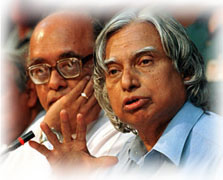| |
| |
Srinivasa
Ramanujan – A genius on the silver screen!!
|
|
| |
You
may wonder for a while why this article
found a place here and that too as a special
one. But, when tomorrow’s film world
goes ga ga about it, you would raise your
collar that you knew this already. India
has produced great mathematicians and scholars
since the Vedic era. However, the most intriguing
and tragic has been the life of Srinivasa
Ramanujan, a Tamilian by birth and dwelling,
who with all his genius could have lived
like a king but died too soon consumed by
penury. The good news is that his life would
soon be made into a film. It would be an
Indo-British joint production. Dev Benegal
and Stephen Fry would be making the film.
|
|
|
From
Chennai to Cambridge
Ramanujan
was born in Erode in 1887 and grew up in Kumbakonam.
He was an introvert child always scribbling
mathematical problems and solutions on every
tiny piece of paper he could lay his hands on.
He was not good in any other subjects. So, he
failed his matriculation exam. He found a job
as a clerk in the Chennai Port Trust, where
he spent all his time writing down complex problems
and their solutions. Craving for recognition
of his talents, he sent 100 proofs to G.H.Hardy,
the noted mathematician at Cambridge. Hardy
was so impressed that he arranged for Ramanujan
to come over to Cambridge and pursue his passion.
But, Ramanujan fell sick because his frail health
could not survive harsh wartime restrictions
and cold weather with his pure vegetarian diet.
He came back to India in 1919 and died a year
later. He was just 33..
|
|
|
|
Rapport
with Hardy
The most important aspect of Ramanujan’s
brief life is his relationship with Hardy,
who was convinced of Ramanujan’s genius.
They shared a wonderful rapport as Hardy
made every attempt to bring Ramanujan’s
work into wider acceptance. Hardy had no
ego in acknowledging that this sickly Indian
had the solutions to some of the stumping
problems in mathematics. |
|
|
Dev
Benegal and Fry
Dev Benegal is a noted film maker with critically
acclaimed work like English August and Split wide
open. Fry, who was educated in Cambridge, is a
multifaceted British actor and writer. A chance
meeting between the two set the ball rolling for
this film. They found it quite interesting that
two men who came from totally different cultural
and social backgrounds could find so much common
thanks to mathematics. |
|
Shoot
in Kumbakonam
The film was formally launched on Monday
in the presence of President Dr. A.P.J.
Abdul Kalam, who wished the team all success
and also handed over some materials he had
written about Ramanujan’s problems.
The film will be shot in Kumbakonam, Erode,
Chennai and of course, Cambridge. Much of
the research has been done from institutional
sources as Ramanujan died young without
a child and his wife died in late1989. Most
of the other family members are either dead
or untraceable. The film will begin shooting
early next year. |
 |
|
|
No
Khans, Aamir and Shah Rukh
A leading British or American actor would
play the lovable Hardy while the hunt is on for
the guy to play Ramanujan. The makers have ruled
out the Khans, Aamir and Shah Rukh. It would be
better if anyone put out a word about our own
Kamal or Vikram to them. Who would be the lucky
one?
The
film on Ramanujan would mark a great shift in
the pattern of film making in English. So far,
India had remained an exotic locale with tales
of kings and queens or the British Raj forming
most of the plot. Then, Gandhi by Richard Attenborough
took him out of the history textbooks to millions
of viewers. Now, Ramanujan’s life would
chronicle an important aspect of how two people
from diverse social and cultural backgrounds came
together breaking all barriers. In that sense,
it is a nice popular interest story as well. It
is a pity that such films are made only with global
partners, while we claim to be the industry churning
out the second largest number of films in the
world. We also have talented technicians, writers
and directors. Well researched stories and heartwarming
biographies are not impossible for them. Until
our films attempt to move out of song and dance,
fight and melodrama routine, cinema would remain
a fringe player without a complete contribution
to the society.
|
|
It’s
Ramanujan’s partition theory helps you at
ATM
Next time when you draw money from an
automated teller machine remember, the machine
uses Ramanujan’s partition theory to arrange
and supply cash to you. We cannot wait to watch
this film on the man who had the solutions for
the digital era but unfortunately died young unsung
and unheralded. |
|
|
|
|
|
|
